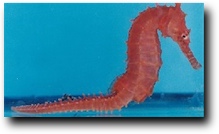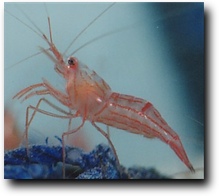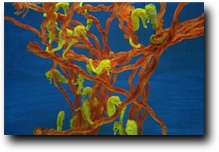Seahorse Care
This fact sheet is courtesy of The Seahorse Sanctuary, Kalbarri, Western Australia.
Seahorse populations around the world are under threat from over-collection for the traditional Chinese medicine market and the aquarium trade. By purchasing tank-bred seahorses, you can enjoy the experience of keeping these remarkable creatures in your own home without contributing to their exploitation in the sea.
The following information will help you to provide the best possible care for your new seahorses.
Your Seahorses
There are several species of captive bred seahorses available. These include the Coral Seahorse (Hippocampus barbouri), the Brazilian seahorse (H. reidi) and the Western Spiny Seahorse (H. angustus). All three species are found in tropical waters and have the same care requirements. Seahorses are best purchased around 6-8 months old, (which makes them the seahorse equivalent of human teenagers!) but with proper care all will grow to a maximum height of around 15cm (from the top of the head to the tip of the tail) and live for about five years.
 Your seahorses have an armour-plated body, which makes them very easy to handle. When necessary, simply grasp them gentle between finger and thumb anywhere between the head and the tail. This is preferable to using a net as they easily become tangled in the mesh. You can lift them out of the water to move them but don't leave them out too long. As your seahorses get used to you, they will wrap their tails around your submerged finger during feeding. They have a strong grip so take care when disengaging them.
Your seahorses have an armour-plated body, which makes them very easy to handle. When necessary, simply grasp them gentle between finger and thumb anywhere between the head and the tail. This is preferable to using a net as they easily become tangled in the mesh. You can lift them out of the water to move them but don't leave them out too long. As your seahorses get used to you, they will wrap their tails around your submerged finger during feeding. They have a strong grip so take care when disengaging them.
Conservation
At this point we would like to stress that if at anytime you no longer wish to keep your seahorses then PLEASE do not release any seahorses (or their offspring) into the local ocean where they do not belong. Instead, return them to the aquarium shop where you purchased them. Tropical species will die in colder water. Should they be released in warmer waters, seahorses could become established and displace seahorses native to your area. To protect natural wildlife, the same precautions should apply to all marine ornamental fish.
Temperature
In the ocean your seahorse is found in tropical waters that are typically around 26ºC. In captivity, your seahorses should be kept at temperatures between 24 and 30ºC. Prolonged temperatures outside this range, as well as any sudden change in temperature, should be avoided. Rapid changes in temperature in a short time is one of the major causes of poor health in seahorses.
Tanks and Tank Mates
Your seahorses will thrive in any system that provides fair to excellent water quality without excessive water currents. Corner foam, box, sub-gravel and canister filters are all suitable. Regular water changes (at least 10% every two weeks) and water testing are necessary for these systems. Water currents are excessive if the seahorses can't catch their food as it swirls past. Retail outlets that carry our stock are well able to provide advice on appropriate set-ups for seahorses. We recommend a minimum tank size of 100 litres as the water temperature does not change quickly with changing room temperatures.
The tank should contain something for the seahorses to attach to, preferably something they can wrap their tails right around, such as thin rope, fake (or real) vegetation, small driftwood branches or thin branching corals. Most seahorses will also use the edges of rocks and larger corals as attachment sites. Your seahorses will certainly appreciate tank decorations that give them the opportunity to hide whenever they are feeling a little shy.
It is best to choose fish species that can be kept in the same tank with seahorses. These include the closely related pipefish, which are colourful and constantly active, and peppermint shrimp, which perform an important task in eating excess food and so help to keep your seahorse tank clean. However, if you wish to keep them with other marine fishes, there are some that must be avoided. Aggressive fishes, such as damsels and clownfish, will stress your seahorses by beating them to their food or even attacking them. Almost all anemones, including Aiptasia, will sting your seahorses causing sores and/or death. Large nocturnal crustaceans, such as crabs, will catch and eat smaller seahorses while they rest at night. 
Feeding
In the sea, seahorses are used to feeding on live shrimps and small fish. When taken from their natural environment and placed in an aquarium, wild seahorses are reluctant to eat dead food and often die of starvation soon after purchase. In contrast, tank-bred seahorses are likely to have been reared on a mixture of frozen mysis shrimp and brine shrimp. It is very important that you feed your seahorses a combination of mysis shrimp and brine shrimp that have been enriched with multi-vitamins. With this diet, your seahorses will stay healthy and grow quickly.
Feeding your seahorses can be very entertaining as you watch them wrestle each other with their prehensile tails to reach the food as it floats past. Your seahorses will snap up their food as it sinks in the water. They will clean up the food that sinks to the bottom as well however, do not allow large quantities of food to sit on the bottom as it will quickly decompose and affect water quality or the health of any seahorse who returns to it later for a snack. By adding the food slowly, you will ensure that most of the food is eaten while it sinks. By counting how many shrimp your seahorse eats at each meal you can adjust your feeding rate accordingly.
Seahorses have no true stomach and so do not digest their food very well, so ideally you should feed your seahorses small quantities of food throughout the day. However, this is not always possible so we recommend that they are fed at least twice per day, once in the morning and again in the afternoon/evening.
To feed them, first place the food in a tea strainer and defrost it under a gently running tap, taking care not to break it up with high water pressure. Add a liquid multi-vitamin preparation (eg SERA) to the food (following manufacturer's directions), gently mix it in and leave the food to stand for at least 15 mins. Tweezers or a spoon can then be used to place small quantities of food into the tank. If you are careful to always add the food at the same place, your seahorses will soon learn to be at that spot when the food arrives. Uneaten food can be stored in the refrigerator provided it is used within 12 hours. The defrosted food can be refrozen in the tea strainer only once before it should be discarded and replaced with fresh food from the packet.
In addition to the frozen food, your seahorses will appreciate some live brine shrimp every so often. This will provide them with some excitement and extra nutrition. It is probably not a good idea to feed them consistently over a long period of time on live brine shrimp as they may be reluctant to return to frozen foods and without nutrient enrichment, live brine shrimp will not contain all the essential nutrients for your seahorses.
Colour
It is not possible to predict the final colour of your seahorse as they resemble chameleons, in that they can change colour to suit their surroundings. When they leave the breeding establishment they may be bright yellow or orange but this colour may change in the retail shop and again when you get them home. As a general rule, in poorly lit tanks, they will go dark in colour (even black if the tank is very dim) so well lit tanks are recommended. It is also recommended to have some brightly coloured tank ornaments to encourage the seahorses to try and blend in. At the Seahorse Sanctuary in Western Australia we use either bright yellow or bright orange rope weighted down with dried coral to help our seahorses achieve a bright colour, and you could try the same trick.
Sex
Your seahorses have some unusual sexual habits. Unlike most other creatures, it is the male who becomes pregnant! The female gives her eggs to the male who collects them in his pouch, fertilises and nurtures them, and finally gives birth to them. The males are easily distinguished from the females by their pouch and the more prominent keel on their abdomen. Please be aware that successful rearing does require highly specialised techniques and is extremely difficult in the home aquarium. We strongly recommend that you purchase seahorses of ONE SEX ONLY for your aquarium in order to avoid disappointment.
Health
The key to seahorse health is keeping them well fed and in a stable environment. Regular feeds and water changes are vital. If your seahorses are exposed to very high light levels, they may develop algal growth on their skin, which can be removed with a soft brush (such as a make-up brush), while holding the seahorse gently under the water. Even with the best care, your seahorses may show symptoms of disease during their life. One of the more common ailments of seahorses is known as gas-bubble disease in which gas bubbles form in the males' brood pouch or under the skin of the tail in either sex. If this, or any other disease occurs, please contact the aquarium shop where you purchased your pet for further advice.



